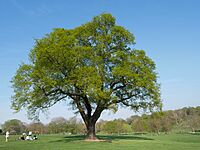Beckenham Place Park facts for kids
Quick facts for kids Beckenham Place Park |
|
|---|---|

Beckenham Place Park is the largest green space in Lewisham
|
|
| Type | public park |
| Location | London, England |
| Area | 96 hectares (237 acres) |
| Created | 1927 (golf course 1907-1929-2016) |
| Operated by | London Borough of Lewisham |
| Status | Open year round |
Beckenham Place Park is a huge park located near Beckenham in London. It's one of the biggest green spaces in the area. The park used to be split between two different parts of London, but now it's all in the London Borough of Lewisham. The beautiful old house, called a Palladian-style mansion, that gave the park its name is now a fun community center and a cafe.
Contents
Park History: From Manor to Park
The land where Beckenham Place Park sits has a long history, going back to medieval times. It was even mentioned in the Domesday Book, a famous survey from 1086!
Who Owned the Land?
For a long time, the land was part of different "manors." A manor was like a large estate with a big house and lots of land around it. In the 17th century, a man named Walter St John owned the whole estate. Later, in 1773, a well-known Quaker and MP (someone who helps make laws) named John Cator bought the land.
John Cator started buying parts of this land as early as 1757. He built the grand mansion you can still see today by 1762.
A Botanist's Paradise
John Cator's father-in-law was a famous plant expert, a botanist named Peter Collinson. Collinson visited the new house in 1762 and was very impressed. He wrote that Cator's new house was on a "pretty wooded estate" and that the plants Cator had added would make it a "Paradise."
Cator was known for planting many interesting and unusual trees. He also created a lake in the park. This lake was dry for a while, but it has been brought back to life! Now, it's a place for wild swimming and a home for many birds. Even today, the park is home to around 60 different kinds of trees.
The Park Through the Years
The Cator family owned the mansion for many years. In the 19th century, it was rented out and used for different things, including a boys' school and a special hospital called a sanitorium in the early 1900s.
In 1927, the London County Council bought the park. A golf course, which had been there since 1907, became the first public golf course in England in 1929. The mansion was used as the clubhouse for the golfers.
During the Second World War, the park had a different role. It became a camp for prisoners of war. There were also defenses like anti-aircraft guns and barrage balloons to protect the area.
After the war, different councils managed the park. Since 1995, the park has been entirely within the Lewisham borough.
Exploring Beckenham Place Park
Beckenham Place Park is the biggest green space in Lewisham, covering about 96 hectares. That's like 120 football fields! It has lots of different things to see and do.
Park Layout and Features
A railway line runs right through the middle of the park, splitting it into two parts. If you want to get from one side to the other, you can use a bridge north of a wooded area called the Ash Plantation. Or, you can leave the park near Ravensbourne railway station and re-enter.
The park is home to very old woodlands and other natural areas. You can find many special trees here, like oak, wild service tree, and sweet chestnut. There's even an ancient Turkey oak tree that was once thought to be the second oldest in Britain! You can also spot an old mulberry tree.
Modern Fun and Nature
In 2019, the park got a big makeover, costing £6.8 million. The old public golf course closed, and new exciting features were added. Now, you can enjoy a wild swimming lake and a cool BMX track for bikes.
Beckenham Place Park is recognized as a Local Nature Reserve. This means it's a special place for nature and wildlife. It's also part of two popular walking routes: the Green Chain Walk and the Capital Ring.
See also




